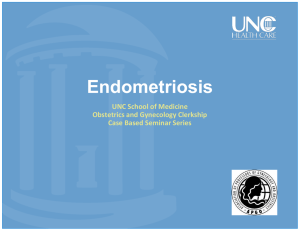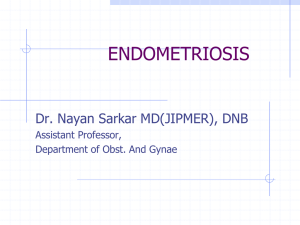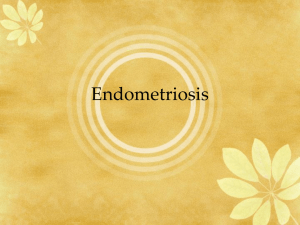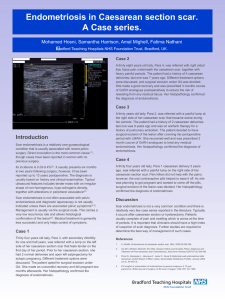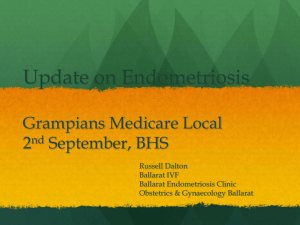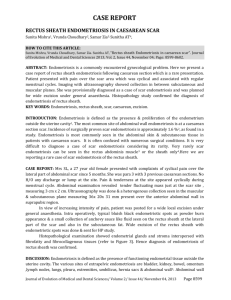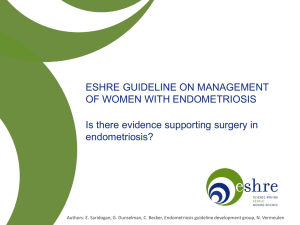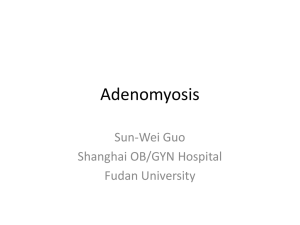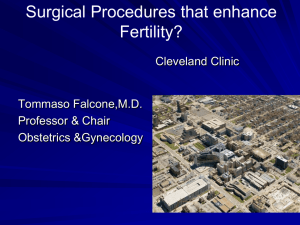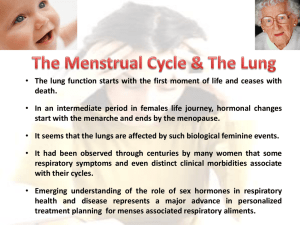Visanne Slide Deck 1
advertisement
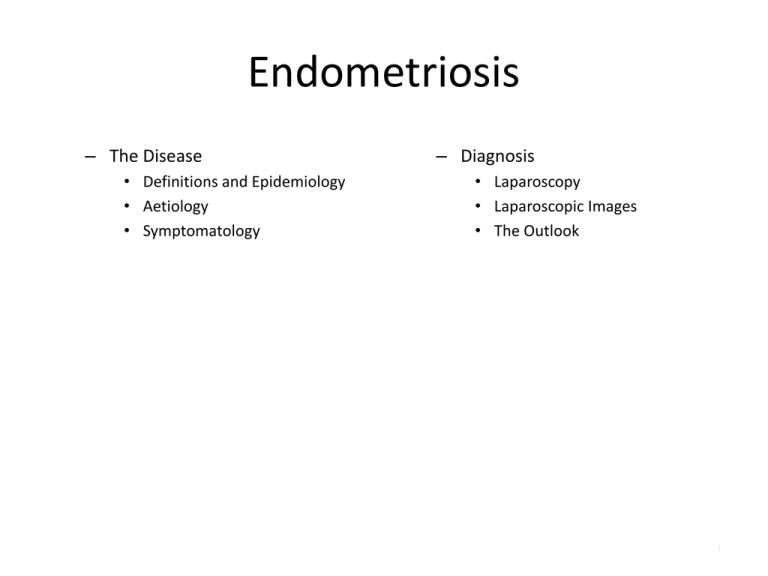
Endometriosis – The Disease • Definitions and Epidemiology • Aetiology • Symptomatology – Diagnosis • Laparoscopy • Laparoscopic Images • The Outlook 1 Endometriosis (continued) – Treatment • • • • • • • • – Summary Current Treatment Options Non-specific Therapies Specific Therapies Progestins Danazol GnRH Agonists Surgery Guidelines 2 Endometriosis: The Disease Definitions and Epidemiology Definitions – ‘The presence of endometrial-like tissue outside the uterus… induces a chronic, inflammatory reaction’1 • Endometriosis: derived from ancient Greek: endo - ‘inside’ and metra - ‘womb’ – ‘…found predominantly in women of reproductive age, from all ethnic and social groups’1 – ‘…associated symptoms can impact on general physical, mental and social well-being’1 1. Kennedy S, Berggvist A, Chapron C et al. Hum Reprod 2005. 4 Epidemiology •Endometriosis is a prevalent condition: – 5–10% of the female population1,2 – ~5.5 million women in USA; ~16 million in Europe3 – Affects women during reproductive years – Younger age at onset predicts more severe disease4 – ~50% in women with dysmenorrhea; 75% in women with pelvic pain; 25–40% in infertile/subfertile women5,6 1. Mounsey AL et al. Am Fam Phys 2006; 4. Ballweg ML et al. J Pediatr Adolesc Gynecol 2003; 2. Eskenazi B & Warner ML. Obstet Gynecol Clin North Am 1997; 5. Child TJ et al. Drugs 2001; 3. Taylor MM AORN 2003; 6. Cramer DW et al. Ann N Y Acad Sci 2002. 5 Endometriosis: The Disease Aetiology Sites Commonly Affected – ‘Extent of disease varies from a few, small lesions on otherwise normal pelvic organs to large, ovarian endometriotic cysts (endometriomas), and/or extensive fibrosis and adhesion formation causing marked distortion of pelvic anatomy’1 – Pelvic cavity: • Peritoneum, ovaries, pouch of Douglas, uterosacral ligaments – Other sites: • Vagina, bowel, bladder, ureters – Rare sites: • Lungs, brain 1. Kennedy S, Berggvist A, Chapron C et al. Hum Reprod 2005. 7 Critical Aspects of Pathogenesis – Endometrial-like cells attach to peritoneal tissue/other sites – Cellular infiltration/invasion, involving angiogenesis – Cellular proliferation – Inflammation which can cause • Nerve irritation • Adhesions – Individual variation Mahutte NG, Kayisli U, Arici A. Endometriosis in Clinical Practice. 2005; Fraser IS. J Hum Reprod Sci 2008. 8 Risk Factors – Pathophysiology unclear – Certain characteristics lead to increased/decreased risk Increased Risk Decreased Risk Increased exposure to endometrial material – short menstrual cycles, heavy/longer bleeding, early menarche, late menopause1,2 Increased number of live births1 Family history3 Longer duration of lactation1 Low exercise4-6 1. Mounsey AL et al. Am Fam Phys 2006; 2. Missmer SA et al. Obstet Gynecol 2004; 3. Bischoff F et al. Ann N Y Acad Sci 2004; 4. Eskenazi B et al. Obstet Gynecol Clin North Am 1997; 5. Cramer DW et al. Ann N Y Acad Sci 2002; 6. Hediger ML et al. Fertil Steril 2005. 9 Endometriosis: The Disease Symptomatology Symptomatology – Typical symptoms: • • • • Dysmenorrhea Premenstrual pain Dyspareunia Diffuse/chronic pelvic pain – Other symptoms: • Perimenstrual symptoms (e.g. bowel- or bladder-associated) • Back pain • Chronic fatigue – Significant proportion of cases asymptomatic – Diagnosis based on symptoms alone can be difficult • Variable presentation • Similar to other conditions – irritable bowel syndrome, pelvic inflammatory disease Sinaii N, Plumb K, Cotton L et al. Fertil Steril 2008. 11 Prevalence and Overlap of Symptoms Pelvic pain + dysmenorrhea 25.2% Dysmenorrhea only 12.7% Pelvic pain only 6.5% Dyspareunia + pelvic pain + dysmenorrhea 34.4% Dysmenorrhea + dyspareunia 6.5% Pelvic pain + dyspareunia 3.3% Dyspareunia only 0.7% Sinaii N, Plumb K, Cotton L et al. Fertil Steril 2008. 10.7% of women did not report any gynecologic pain symptoms. 12 Infertility – Endometriosis is frequently associated with infertility • 30–40% experience subfertility or infertility – Lesions cause chronic inflammation/adhesions, impacting fertility – Infertility may be the sole presenting symptom • 25–40% of infertile women have endometriosis – Endometriosis may be diagnosed by chance by an infertility specialist Ozkan S, Murk W, Arici A. Ann NY Acad Sci 2008. 13 Natural History of Disease – Highly variable and difficult to predict in individual women – Progressive course characterised by worsening of pain1 – Younger onset age predicts more severe disease course2 – Spontaneous regression is possible3 1. Koninckx PR, Meuleman C, Demeyere S et al. Fertil Steril 1991; 2. Ballweg J Pediatr Adolesc Gynecol 2003; 3. Mahmood TA, Templeton A. Hum Reprod 1990. 14 What is the Impact of Endometriosis? Quality of life Morbidity Absenteeism Socio-economic cost Educational opportunities Daily function Self-esteem Fertility Mounsey AL, Wilgus A, Slawson DC. Am Fam Phys 2006; Gao X, Yeh YC, Outley J et al. Curr Med Res Opin 2006. 15 Endometriosis: Diagnosis Diagnosis Diagnosis often delayed (average 8.3 years1) Suggestive Laparoscopic visualisation – ideally with confirmatory histology1 Typical clinical symptoms and signs (e.g. uterosacral nodularity)2,3 Magnetic resonance imaging and ultrasound4 Definitive New techniques Laboratory tests currently fail to show predictive value5,6 New semi-quantitative procedures being assessed7 1. Kennedy S, Bergqvist A, Chapron C, et al. Hum Reprod 2005; 2. Mounsey AL, Wilgus A, Slawson DC. Am Fam Phys 2006; 3. Matorras R, Rodríguez F, Pijoan JI, et al. Am J Obstet Gynecol 1996; 4. 5. 6. 7. Bazot et al. J Minim Invasive Gynecol 2005; Bedawy et al. Clin Chem Acta 2004; Matalliotakis et al. Arch Gynecol Obstet 2005; Fraser et al. J Hum Reprod Sci 2008. 17 Diagnostic Pathway Clinical presentation: typical symptoms Endometriosis suspected History Examination Investigations Consider differential diagnoses Likely diagnosis of endometriosis – management considerations 18 Typical Symptoms – Dysmenorrhea • Most commonly reported symptom • Severe form highly suggestive of endometriosis1 – Dyspareunia • Commonly found in peritoneal (88%) and rectovaginal (100%) disease2 – No relationship between stage and site of disease – Normal clinical examination cannot exclude endometriosis3–5 1. Mahmood TA, Templeton A. Hum Reprod 1991; 2. Gruppo Italiano per lo Studio dell’Endometriosis. Hum Reprod 2001. 3. Koninckx PR, Meuleman C, Oosterlynck D et al. Fertil Steril 1996; 4. Chapron C, Dubuisson JB, Pansini V et al. Fertil Steril 2002; 5. Eskenazi B, Warner M, Bonsignore L et al. Fertil Steril 2001. 19 Endometriosis: Diagnosis Laparoscopy Laparoscopy: Advantages and disadvantages Advantages Disadvantages2,3 Gold standard investigation technique1 Facilities/surgical expertise not universally available Possibility to diagnose and treat during one procedure Not all patients are suitable for invasive techniques False-positive and false-negative findings Risk of complications 1. Kennedy S, Bergqvist A, Chapron C et al. Hum Reprod 2005; 2. Brosens IA, Brosens JJ. Eur J Obstet Gynecol Reprod Biol 2000; 3. Al-Jefout M, Dezarnaulds G, Cooper M et al. Hum Reprod 2009. 21 Laparoscopic Technique 22 Laparoscopic Technique 23 Laparoscopic Findings – Lesions1 • ‘Powderburn’/‘gunshot’ lesions on ovaries, serosal surfaces, peritoneum – Black, dark-brown or bluish puckered lesions, nodules or small cysts containing old hemorrhage surrounded by variable extent of fibrosis • Atypical or ‘subtle’ lesions – implants (petechial, vesicular, polypoid, hemorrhagic, red flame-like), serous/clear vesicles • White plaques/scarring, yellow-brown discoloration of peritoneum – Endometriomas (‘chocolate cysts’)1 • Contain thick tar-like fluid – Deeply infiltrating endometriotic nodules1 • Extend >5 mm beneath peritoneum • May involve uterosacral ligaments, vagina, bowel, bladder or ureters • Depth of infiltration related to type and severity of symptoms 1. Kennedy S, Berggvist A, Chapron C et al. Hum Reprod. 2005. 24 Laparoscopic Disease Classification (rASRM Score) rASRM, revised American Society for Reproductive Medicine. Revised American Society for Reproductive Medicine. Fertil Steril 1997. 25 Laparoscopic Disease Classification (rASRM Score) MINIMAL Stage 1 (1–5 points) Small superficial implants, not widespread, filmy adhesions MILD Stage 2 (6–15 points) Small to medium implants (1–3 cm), slightly deeper in peritoneum and ovary, filmy adhesions MODERATE Stage 3 (16–40 points) Large widespread implants, extensive scar tissue, filmy/dense adhesions SEVERE Stage 4 (>40 points) Large implants and endometriomas, extensive scar tissue, deep and dense adhesions – Lesion assessment based on points system at laparoscopy1 – Classification may help determine risk of infertility – No correlation between classification and symptoms2 1. Revised American Society for Reproductive Medicine. Fertil Steril 1997; 2. Kennedy S, Berggvist A, Chapron C et al. Hum Reprod 2005. 26 Endometriosis: Diagnosis Laparoscopic Images Laparoscopic Images 28 Laparoscopic Images 29 Laparoscopic Images 30 Endometriosis: Diagnosis The Outlook Diagnosis Non-invasive techniques remain under investigation Detection of nerve fibres in endometrial biopsy1 Biopsy Laboratory tests (e.g. serum cancer antigens CA 125, CA 19-9, serum IL-6, peritoneal fluid TNFα), fail to show predictive value4,5 Lab-based tests Imaging Ultrasound, computerised tomography scan or magnetic resonance imaging – may be useful adjunctive investigations2,3 Transvaginal ultrasound can detect e.g. endometriomas (but not lesions)1 1. Kennedy S, Bergqvist A, Chapron C, et al. Hum Reprod 2005; 2. Mounsey AL, Wilgus A, Slawson DC. Am Fam Phys 2006; 3. Matorras R, Rodríguez F, Pijoan JI, et al. Am J Obstet Gynecol 1996; 4. 5. 6. 7. Bazot et al. J Minim Invasive Gynecol 2005; Bedawy et al. Clin Chem Acta 2004; Matalliotakis et al. Arch Gynecol Obstet 2005; Fraser et al. J Hum Reprod Sci 2008. 32 Endometriosis: Treatment Current Treatment Options Overview – No permanent cure for endometriosis – Aims of treatment (patient-dependent): • • • • • Alleviate pain and other symptoms Reduce lesions Maintain/restore fertility Avoid recurrence Improve quality of life 34 Individualisation of Therapy – No single approach ideal for all patients – Tailor therapy to needs and choices of patient1 – Objective of individualised therapy: • Manage complaint (pain/infertility) • Optimise balance of efficacy, safety and tolerability profiles • Enhance adherence 1. Kennedy S, Berggvist A, Chapron C et al. Hum Reprod 2005. 35 Surgical Therapy – Aimed at removing endometrial implants and restoring fertility – Efficacy reflects the skill of the surgeon – Recurrence is common: 40–50% at 5 years1,2 1. Mounsey AL, Wilgus A, Slawson DC. Am Fam Phys 2006; 2. Guo SW. Hum Reprod Update 2009. 36 Medical Therapy Non-specific therapies – not approved in endometriosis Specific therapies – approved in endometriosis Including non-steroidal anti-inflammatory drugs and combined oral contraceptives e.g. gonadotropin-releasing hormone agonists, danazol and some progestins 37 Treatment Approach •‘Endometriosis should be viewed as a chronic disease that requires a life-long management plan with the goal of maximising the use of medical treatment and avoiding repeated surgical procedures’ Practice Committee of the American Society for Reproductive Medicine. Fertil Steril 2008. 38 NSAIDs – – – – General, non-specific pain relief Controlled trial data lacking1,2 No single NSAID shows superior efficacy1 Potential adverse effects in gastrointestinal tract1,2 NSAID, non-steroidal anti-inflammatory drug. 1. Allen C, Hopewell S, Prentice A. Cochrane Database Syst Rev 2005; 2. Kennedy S et al. Hum Reprod 2005. 39 Combined Oral Contraceptives – Combined oral contraceptives are widely used off-label for endometriosis – Lack of randomised controlled trials1,2 – Limited guidance on optimal regimens – Estrogen in oral contraceptives appears counter-productive for endometriosis treatment2 • Hormonal therapies indicated for endometriosis counteract estrogen effects on endometrial tissue – Estrogenic adverse effects (nausea, weight gain, water retention, increased thromboembolic risk)1 1. Davis LJ, Kennedy SS, Moore J et al. Cochrane Database Syst Rev 2007; 2. Crosignani P, Olive D, Bergqvist A et al. Hum Reprod Update 2006. 40 Endometriosis: Medical therapy Specific Therapies Hormonal Therapy* GnRH agonists Progestins / antiprogestin (suppression of FSH/LH via desensitisation and down-regulation of pituitary GnRH receptors) (suppression of FSH/LH, some have additional properties, e.g. antiinflammatoric) • • • • • • • • • • • Leuprolin Goserelin Buserelin Triptorelin Nafarelin Avorelin MPA (oral/im/sc) Dydrogesterone Norethisterone Dienogest Gestrinone Androgens (suppression of FSH/LH, anti-estrogenic and hyperandrogenism) • Danazol * Not all products are available in all countries. FSH, follicle stimulating hormone; GnRH, gonadotropin-releasing hormone; LH, luteinizing hormone; MPA, medroxyprogesterone acetate Vercellini et al. Best Pract Res Clin Obstet Gynaecol 2008; Mihalyi et al. Expert Opin Emerg Drugs 2006. 42 Endometriosis treatment: Progestins Progestins – Synthetic hormones with progesterone-like activity1,2 – First used to treat endometriosis in the 1950s3, most have not been developed for the treatment of endometriosis – Derived from different steroids (e.g. progesterone, testosterone), differ in their actions – Limited evidence from controlled (especially placebo-controlled) trials, scarcity of data also hampers the selection of one progestin over another – Adverse events include irregular bleeding and (especially with older agents) weight gain, headaches, acne and adverse lipid changes4,5 – Newer types selectively bind progesterone receptors specifically to minimise androgenic, estrogenic or glucocorticoid side-effects1 1. Sitruk-Ware R. Hum Reprod Update 2006; 2. Schindler AE et al. Maturitas 2003; 3. Kistner RW. Am J Obstet Gynecol 1958; 4. Winkel CA & Scialli AR. J Womens Health Gend Based Med 2002; 5. Vercellini P et al. Hum Reprod Update 2003. 44 Endometriosis treatment: GnRH Agonists GnRH Agonists – Synthetic peptides modelled on hypothalamic GnRH – Mechanism of action: down-regulation of pituitary gonadotropin secretion, inducing a hypoestrogenic anovulatory state1,2 – Considered ‘standard’ treatment for endometriosis due to high efficacy1–4 – Hypoestrogenic side-effects, including BMD decrease – Limited to short-term use (6 months) in absence of ‘add-back’ therapy • ‘Add-back’ therapy adds to expense; optimal regimens not established • Caution in younger women not reached maximum BMD GnRH, gonadotropin-releasing hormone; BMD, bone mineral density. 1. 2. 3. 4. Winkel CA et al. J Women’s Health Gender-Based Med 2001; Sinaii N et al. Fertil Steril 2007; Crosignani P et al. Hum Reprod Update 2006; Mounsey AL et al. Am Fam Phys 2006. 46 Endometriosis: Surgical therapy Surgery Surgical Treatment – Usually performed as laparoscopy in one procedure combining diagnosis and treatment – Surgical intervention includes: excision or ablation of endometriotic lesions, removal of endometriotic cysts, adhesiolysis1 – Frequently combined with follow up medical therapy – Preferred approach in infertile patients2 – Role in pain relief unclear2 – Success reflects the skill of practitioner – Recurrence of endometriosis is common – 5-year recurrence rate approximately 40–50%3 1. Mounsey AL, Wilgus A, Slawson DC. Am Fam Phys 2006; 2. Jacobson TZ et al. Cochrane Database 2008; 3. Guo SW. Hum Reprod Update 2009. 48 Laparoscopic Technique 49 Endometriosis: Summary Summary •Burden – Physical, mental and social well-being, fertility and quality of life •Awareness – Lack of awareness •Diagnosis – Difficulties and delays •New therapies – Need for more effective therapies with acceptable tolerability •Progestins – Recommended therapy, efficacious in treating symptoms 51 Endometriosis Questions?
